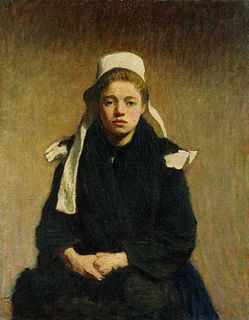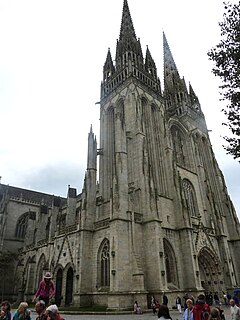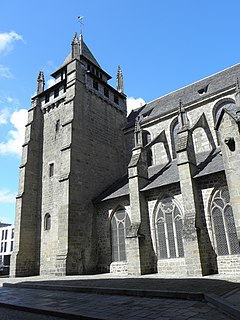
Brittany is a peninsula, historical country, and cultural area in the west of modern France, covering the western part of what was known as Armorica during the period of Roman occupation. It became an independent kingdom and then a duchy before being united with the Kingdom of France in 1532 as a province governed as a separate nation under the crown.

Samson of Dol was a Cornish saint, who is also counted among the seven founder saints of Brittany with Pol Aurelian, Tugdual or Tudwal, Brieuc, Malo, Patern (Paternus) and Corentin. Born in southern Wales, he died in Dol-de-Bretagne, a small town in north Brittany.

Odo of Rennes, Count of Penthièvre, was the youngest of the three sons of Duke Geoffrey I of Brittany and Hawise of Normandy, daughter of Richard I of Normandy. Eudon married Agnes of Cornouaille, the daughter of Alan Canhiart, Count of Cornouaille and sister of Hoel II, Duke of Brittany who was married in 1066 to Eudon's niece Hawise, Duchess of Brittany.

Vannes is a commune in the Morbihan department in Brittany in north-western France. It was founded over 2,000 years ago.

Saint Tudwal, also known as Tual, Tudgual, Tugdual, Tugual, Pabu, Papu, or Tugdualus (Latin), was a Breton monk, considered to be one of the seven founder saints of Brittany.
Tro Breizh is a Catholic pilgrimage that links the towns of the seven founding saints of Brittany. These seven saints were Celtic monks from Britain from around the 5th or 6th century who brought Christianity to Armorica and founded its first bishoprics.

The Bretons are a Celtic ethnic group native to Brittany. They trace much of their heritage to groups of Brittonic speakers who emigrated from southwestern Great Britain, particularly Cornwall and Devon, mostly during the Anglo-Saxon invasion. They migrated in waves from the 3rd to 9th century into Armorica, which was subsequently named Brittany after them.

The Diocese of Quimper (–Cornouaille) and Léon is a Latin Church ecclesiastical territory or diocese of the Catholic Church in France. In 1853, the name was changed from the Diocese of Quimper (–Cornouaille) to the Diocese of Quimper (–Cornouaille) and Léon.

Saint-Brieuc Cathedral is a Roman Catholic church located in the town of Saint-Brieuc, Brittany, France, and dedicated to Saint Stephen.

Saint Corentin is a Breton saint. He was the first bishop of Quimper. Corentin was a hermit at Plomodiern and was regarded as one of the seven founding saints of Brittany. He is the patron saint of Cornouaille, Brittany, and is also the patron saint of seafood. His feast day is December 12.

The Roman Catholic Archdiocese of Rennes, Dol, and Saint-Malo is a diocese of the Latin Rite of the Roman Catholic Church in France. The diocese is coextensive with the department of Ille et Vilaine. The Archdiocese has 8 suffragans: the Diocese of Angers, the Diocese of Laval, the Diocese of Le Mans, the Diocese of Luçon, the Diocese of Nantes, the Diocese of Quimper and Léon, the Diocese of Saint-Brieuc and Tréguier, and the Diocese of Vannes.

The Breton and French Catholic diocese of Dol existed from 848 to the French Revolution. It was suppressed by the Concordat of 1801. Its see was Dol Cathedral. Its scattered territory was shared mainly by the Diocese of Rennes and the Diocese of Saint-Brieuc.

The Roman Catholic Diocese of Saint-Brieuc and Tréguier is a diocese of the Latin Rite of the Roman Catholic Church in France. The diocese comprises the department of Côtes d'Armor in the Region of Brittany. The diocese is currently suffragan to the Archdiocese of Rennes, Dol, and Saint-Malo. The current bishop is Denis Moutel, appointed in 2010.

The Roman Catholic Diocese of Nantes is a diocese of the Latin Rite of the Roman Catholic Church in Nantes, France. The diocese consists of the department of Loire-Atlantique. It has existed since the 4th century. It is now suffragan of the Archdiocese of Rennes, Dol, and Saint-Malo, having previously been suffragan to the Archdiocese of Tours. Its see is Nantes Cathedral in the city of Nantes.

Upper Brittany is the eastern part of Brittany, France, which is predominantly of a Romance culture and is associated with the Gallo language. The name is in counterpoint to Lower Brittany, the western part of the ancient province and present-day region, where the Breton language has traditionally been spoken. However, there is no certainty as to exactly where the line between 'Upper' and 'Lower' Brittany falls.

The language boundary in Brittany is the language border between the part of Brittany where Breton is spoken and the area in Brittany where Gallo is spoken. The existence of this linguistic border led to differentiate the Celtic-speaking Lower Brittany (West) from the Romance-speaking Upper Brittany (East).

Jean de Malestroit was a French pseudo-cardinal who served as Bishop of the Roman Catholic Diocese of Nantes from 17 July 1419 until 1443 AD when he resigned.
Albert Le Grand was a Breton hagiographer and a Dominican brother.

Saint Pompeia, also known as Aspasia, is a legendary Breton saint who supposedly lived in the 6th century. Her feast day is celebrated on 2 January.